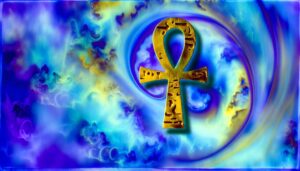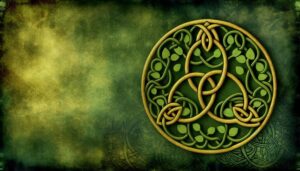Dash Symbol Meaning in English Writing
The dash symbol in English comprises three forms: em dash, en dash, and hyphen, each fulfilling distinct stylistic and grammatical functions. The em dash (—) creates strong breaks within sentences, emphasizing parenthetical elements or abrupt changes in tone.
The en dash (–) indicates ranges like dates or numerical spans, and connects related items in compound adjectives. The hyphen (-) joins words or parts, forming compound terms and avoiding ambiguity.
Misusage of these symbols can lead to confusion, diminishing clarity in writing. Understanding the specific applications of each dash type is essential for precise and effective communication.
Discover more about how dashes enhance writing techniques.

Key Takeaways
- The em dash is used for strong breaks, setting off parenthetical elements, and adding emphasis in sentences.
- The en dash indicates ranges like dates, numerical spans, and connects related items in compound adjectives.
- The hyphen joins words or parts of words to form compound terms and avoid ambiguity.
- Dashes can clarify lists within sentences and improve readability by separating listed items.
- Dashes help indicate abrupt changes in tone or subject matter, enhancing narrative flow and clarity.
Types of Dashes
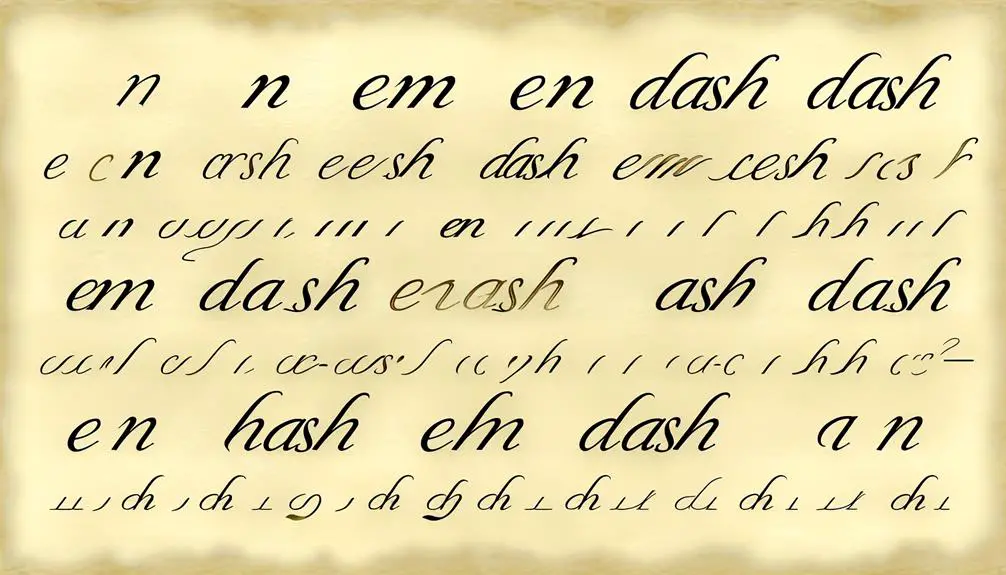
The English language employs three distinct types of dashes—em dash, en dash, and hyphen—each serving unique grammatical and stylistic functions.
The em dash (—) is the longest and typically used to create strong breaks in sentences or to set off parenthetical elements.
The en dash (–), shorter than the em dash but longer than the hyphen, is primarily employed to indicate ranges, such as dates or numerical spans.
The hyphen (-) is the shortest and serves to join words or parts of words, such as in compound adjectives or to avoid ambiguity in certain expressions.
Mastery of these dashes enhances both the clarity and the nuance of written communication, tailoring it precisely to the intended meaning.
Em Dash Usage
The em dash serves as a versatile punctuation mark, particularly effective in separating clauses to enhance readability and coherence.
Additionally, it provides a clear mechanism for adding emphasis within a sentence, allowing writers to highlight critical information.
Understanding the precise usage of the em dash can greatly improve the clarity and impact of written communication.
Separating Clauses Effectively
An em dash serves as a versatile punctuation mark that can effectively separate independent clauses within a sentence, providing clarity and emphasis.
Unlike commas or semicolons, the em dash introduces a more pronounced break, akin to a pivot in thought or a brief pause in speech. This punctuation device allows writers to delineate related yet distinct ideas within a single sentence structure.
For instance, consider the sentence: 'The project was a success—despite numerous setbacks.' Here, the em dash separates the main clause from the contrasting clause without altering the sentence's overall meaning. Its application not only enhances readability but also guarantees a smoother cognitive shift for the reader, thereby maintaining coherence and fluidity in written communication.
Adding Emphasis Clearly
Frequently, the em dash is employed to add emphasis to specific elements within a sentence, thereby drawing the reader's attention to important information. This punctuation mark serves to isolate and highlight critical details, making the conveyed message more impactful. Below is a table illustrating various contexts where the em dash can be effectively used:
| Context | Example | Explanation |
|---|---|---|
| Interruptions | "The results—surprisingly—were conclusive." | Emphasizes the surprising nature of results. |
| Additional Information | "Her decision—unquestionably final—stood." | Highlights the finality of her decision. |
| Contrast | "We expected delays—none occurred." | Stresses the unexpected absence of delays. |
En Dash Usage
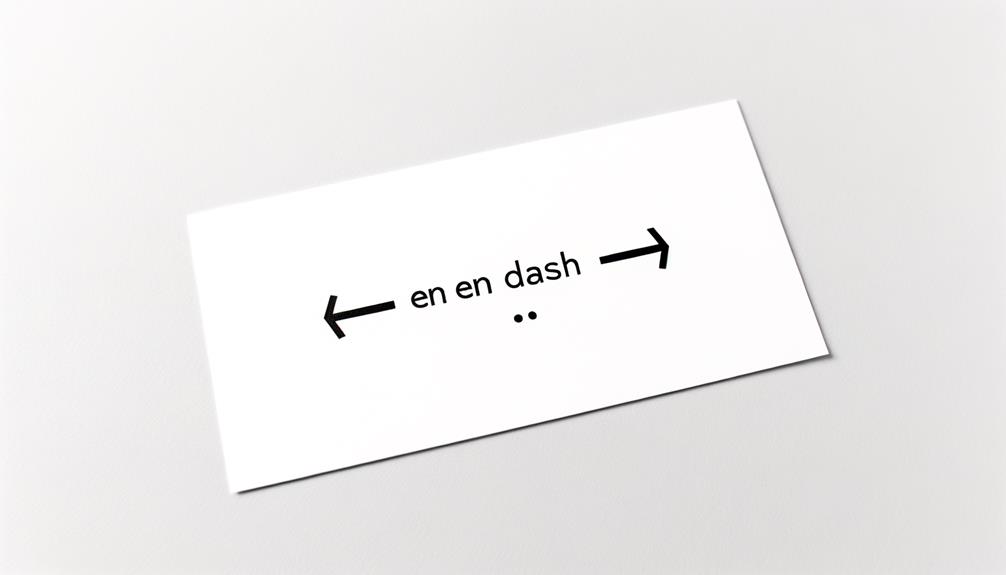
Often employed to denote a range of values, the en dash serves as a versatile punctuation mark in English writing.
This small horizontal line (–) is longer than a hyphen but shorter than an em dash. Its primary function is to indicate spans of time, dates, or numerical ranges, such as '1990–2000' or 'pages 50–60'.
Additionally, the en dash is used to connect related items, particularly in compound adjectives involving multi-word elements, like 'New York–London flight'. By distinguishing relationships more clearly than a hyphen, the en dash enhances readability and precision in text.
It is important to note that proper usage requires spaces on neither side of the en dash, ensuring a streamlined appearance.
Hyphen Vs. Dash
The hyphen and dash, though visually similar, serve distinct functions in English typography.
This section will clarify their usage differences, address common typographical errors, and explore their contextual applications.
Understanding these distinctions is essential for ensuring precise and effective written communication.
Usage Differences Explained
While both hyphens and dashes serve as punctuation marks in English, their functions and appropriate contexts differ substantially.
A hyphen (-) primarily connects words to form compound terms such as 'high-speed' or 'well-known.' It also aids in word division at line breaks.
Conversely, dashes are longer and serve distinct purposes. The en dash (–) indicates ranges (e.g., 'pages 10–20') and relationships (e.g., 'New York–London flight').
The em dash (—), often used for emphasis or interruption, separates additional information or a sudden break in thought within a sentence.
Understanding the specific usage of hyphens and dashes enhances clarity and precision in written communication, ensuring the intended meaning is conveyed effectively.
Common Typographical Errors
Misuse of hyphens and dashes is a frequent typographical error that can lead to ambiguity and misinterpretation in written texts.
Hyphens (-) are used to join words or parts of words, forming compound terms like 'well-being' or connecting prefixes such as 'pre-existing.'
In contrast, dashes—specifically the en dash (–) and em dash (—)—serve distinct purposes.
The en dash indicates ranges or relationships, such as '1990–2000' or 'New York–London flight,' while the em dash is employed for parenthetical statements or to create emphasis, as seen in 'He was late—uncharacteristically so.'
Misapplying these punctuation marks can obscure the intended meaning, reducing the clarity and precision of the text. Understanding their correct usage is essential for effective communication.
Contextual Applications
Correct usage of hyphens and dashes is essential for conveying precise relationships and structures within a text. While both serve to connect ideas, their applications differ significantly.
Hyphens (-) are typically used to join words and create compound terms. In contrast, dashes—either en dashes (–) or em dashes (—)—serve to link or separate larger syntactical units.
- Hyphen (-): Used in compound words (e.g., well-known).
- En Dash (–): Indicates ranges (e.g., 1999–2010).
- Em Dash (—): Creates a break in thought or adds emphasis (e.g., She was right—absolutely right).
- Hyphenation: Essential for clarity in multi-word adjectives (e.g., long-term plan).
- Dash in Lists: Em dashes can introduce additional information or explanations.
Understanding these distinctions guarantees grammatical precision and clarity.
Common Mistakes
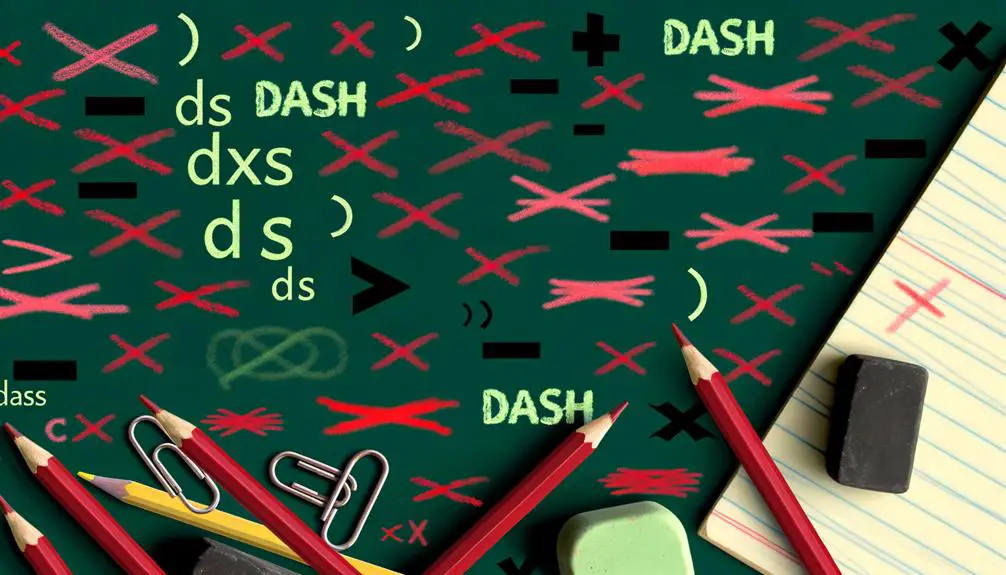
One frequent error encountered when using the dash in English writing is the inappropriate substitution of dashes for other punctuation marks, such as commas, colons, or parentheses. This misuse often leads to ambiguities and disrupted sentence flow.
For instance, dashes should not replace commas in a list, as it can obscure the intended separation of items. Similarly, substituting a dash for a colon can confuse readers about the introduction of a list or explanation.
Moreover, using dashes instead of parentheses can alter the emphasis and disrupt the text's rhythm. Understanding the specific functions of each punctuation mark is essential to avoid these common mistakes and maintain clarity and coherence in writing.
Precision in punctuation usage is crucial for effective communication.
Dash in Formal Writing
While avoiding common mistakes is fundamental, understanding the appropriate use of dashes in formal writing is equally important for maintaining the integrity and professionalism of the text. Dashes can serve as a powerful tool when used correctly, providing clarity and emphasis without compromising formality.
In formal writing, consider the following applications:
- Emphasizing Important Information: Use dashes to highlight key points or pivotal information.
- Setting Off Appositives: Enclose non-essential clauses or phrases that provide additional context.
- Indicating Abrupt Changes: Mark sudden shifts in tone or subject matter.
- Clarifying Lists Within Sentences: Separate listed items for better readability.
- Introducing Explanatory Elements: Precede explanations or elaborations that follow the main clause.
Utilizing dashes effectively can enhance the readability and precision of formal documents.
Dash in Creative Writing

In creative writing, dashes serve as versatile tools that can add nuance, rhythm, and emphasis to the narrative. Their primary function is to introduce a pause, allowing writers to inject additional information or highlight particular elements within a sentence.
This interruption can create a dramatic effect, subtly guiding the reader's attention. Additionally, dashes can be employed to separate clauses in a manner that maintains fluidity without the rigid structure imposed by commas or parentheses.
They offer a dynamic way to juxtapose contrasting ideas or to elaborate on a point without disrupting the narrative flow. Consequently, the strategic use of dashes enhances the expressive potential of creative writing, making it more engaging and impactful.
Examples in Literature
Numerous renowned authors have employed dashes to enhance their storytelling, illustrating the versatility and impact of this punctuation mark in literature. The dash serves multiple functions, from conveying sudden interruptions to emphasizing particular thoughts.
For example, Emily Dickinson's poetry frequently uses dashes to create pauses, injecting emotion and reflection. Similarly, James Joyce often utilized dashes in 'Ulysses' to mimic natural speech patterns and internal monologues.
In 'Moby-Dick,' Herman Melville's use of dashes introduces abrupt shifts and dramatic pauses, enriching narrative tension. Virginia Woolf's 'Mrs Dalloway' employs dashes to reflect characters' stream of consciousness.
- Emily Dickinson's poetry
- James Joyce's 'Ulysses'
- Herman Melville's 'Moby-Dick'
- Virginia Woolf's 'Mrs Dalloway'
- William Faulkner's 'The Sound and the Fury'
These examples underscore the dash's literary significance.
Conclusion
Ironically, the dash—often perceived as a mere punctuation mark—holds significant weight in the English language.
Its various forms, such as the em dash and en dash, serve distinct functions, often misunderstood or misused.
The nuanced roles of dashes in formal and creative writing reveal their subtle power.
The contrast with hyphens further highlights the dash's unique importance.
Ultimately, the dash's versatility and complexity underscore its indispensable role in effective written communication.



